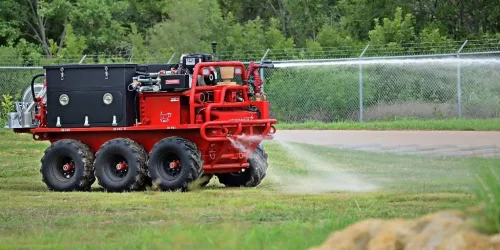Robotics in firefighting
Fire extinguishing by robotic firefighting systems
Fire is a classic element that has been on earth in equal measure since before the beginning of written history. Fire has many positive qualities, including heat, energy, purification, etc., but out of control, it can be very dangerous. Structure, vehicle, ship, aircraft fire can wreak havoc and cause serious injury or death. There are brave men and women who dedicate their lives to protecting others from flames and fires that can happen anywhere, anytime, for any number of reasons. Unfortunately, due to the fact that firefighters are only human, it should be known that they may also be exposed to injury or death during a fire. Robotics in fire fighting is one of the fire extinguishing methods that is still being developed.
In this article, we intend to examine the use of robotic in firefighting.
According to the announcement of the National Fire Protection Association, 29,130 people were injured during the fire in 2015. These injuries are associated with 68 deaths on the spot. Injuries and fatalities have led safety experts, government and advanced companies to come together to create firefighting robots that can perform tasks for people in extremely dangerous situations.

Fire fighting technology
Robotic systems in firefighting are designed with specific tasks in mind, which include fire analysis and location.
Conducting search and rescue, monitoring dangerous variables and fire control are also other duties.
Robotic systems in fixed firefighting, such as automatic sprinklers and alarms, are used in densely populated and dangerous areas to quickly extinguish any threat.
These are usually simpler systems that rely on UV or IR sensors and, as the name suggests, are fixed.
Mobile robotic firefighting systems are another type that are mostly attached to remote control vehicles for fire suppression tools such as water or floor hoses.
These are capable of traveling to unsafe areas through an array of sensors, optical camera, IR and more technologies that transmit information to a remote operator for navigation.
Safety experts and engineers are even experimenting with aerial robotics, such as drones, for added location awareness, so indoor robots have the ability to put out fires at close range.
Below are some real advances in firefighting robots that could reduce the number of injuries and fatalities caused by fires.
THOR / SAFFiR robot
THOR was developed for the US Navy’s Ship Fire Fighting Robot (SAFFiR) program. It is a humanoid robot capable of traversing uneven floors on ships, as well as being able to use hoses and open doors. Navy ships carry hazardous materials that require minimal space to move, so firefighting is critical.
Standing 177cm tall, it uses stereoscopic thermal imaging and LIDAR (Light Detection And Ranging) sensors for navigation and successfully puts out parts of a fire with one person.
The goal is for THOR to be able to walk and operate semi-autonomously with the help of a remote operator. However, for now, there are still some drawbacks. The device is slow and susceptible to fire and water damage. These challenges are overcome while it can put out massive fires for people close to the scene.

Thermite robot
Originally a small tank was developed for the US military by Howe and Howe Technologies.
This remote control vehicle comes with a convenient hose capable of pumping 500 gallons of water per minute. Using built-in cameras, it can navigate extremely dangerous situations like massive wildfires while being monitored from up to a quarter of a mile away.
It weighs 1,640 pounds and was designed as an IED (explosive device) neutralizer.
With some firefighting modifications, it can also be used as a fire extinguisher.
The processor is an innovative cooling system that provides device stability by using some pumped water as a coolant in its body.
Although it uses one-third less water than a fire engine (1,500 gallons per minute), it costs significantly less and its ability to enter dangerous areas without harming people is greater.
Therefore, we can expect to be able to put out huge fires with it in the future.

Robotics in firefighting
Turbine-assisted fire extinguisher (TAF 20 robot)
Created by Emicontrols, a subsidiary of TechnoAlpin Group.
It uses a turbine as an innovative method in firefighting. This means that for small spaces such as tunnels, it has the ability to remove obstacles with its bulldozer blade.
This robot cleans the smoke with its turbine and focuses on its water spray from fog and dust to the fountain.
It’s a tracked vehicle that uses a turbine to move water into a large mist, covering a larger area while using less water.
In special cases, the water can be concentrated into a powerful fountain capable of spraying 3500 liters per minute.
It should be noted that the operators can be up to 500 meters away, but due to its connection with the water hose, it is limited like other Robotics in firefighting.

Fire Ox robot
Fire Ox is one of the few robotic fire trucks that carries its own water tank. Designed as a first response unit, it suppresses fires, assists in search and rescue, and can handle and remove hazardous materials. Originally developed by Lockheed Martin as the Team National Mission Support System (SMSS) to assist soldiers with their equipment in the field, it was retrofitted with a water tank and hose for distribution.
The Fire Ox is semi-autonomous and can be controlled up to 200 miles away. Due to its mobility, it has the ability to pass through unsafe situations for people, minimizing casualties and rescue time. It can also be used in many situations including massive fires and structure fires. This robot is the inspiration for many robotics projects in Ateshani.

Continuing the development of robotics in firefighting
Firefighting robots for more common use in this field are still being developed and perfected. Occupational safety professionals are working with other professionals and government agencies to make futuristic technology a reality. The safety of firefighters and victims caught in a fire is very important, and we demand the production of these robots in the best possible way. These have the ability to withstand environments that are too dangerous for people and can prevent further damage that may occur with traditional methods.
دیدگاه خود را با ما در میان بگذارید














